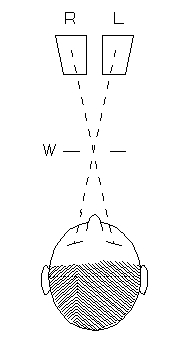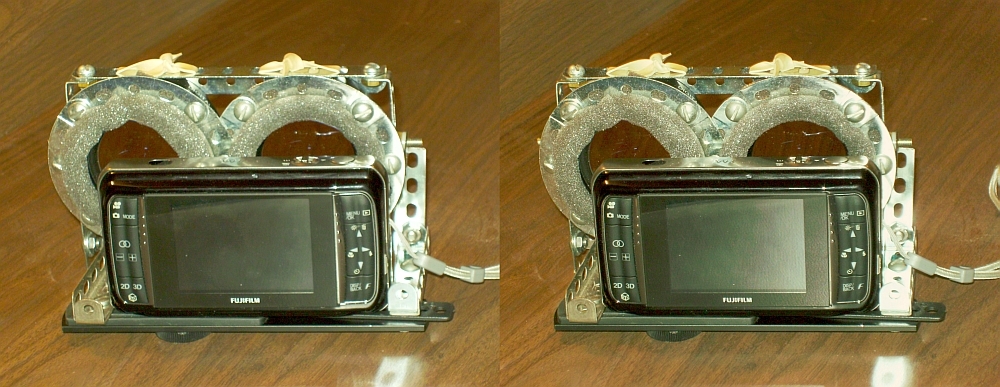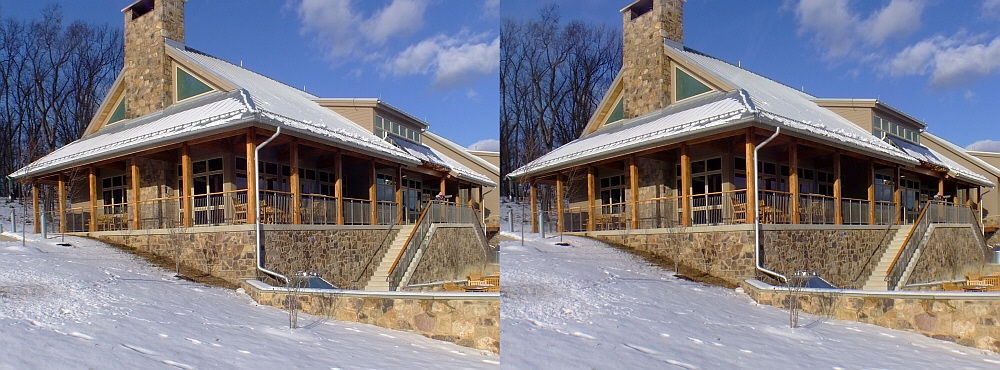
Accessorizing Your Stereo Camera.
Digital Stereos for Cross-Eyed Viewing.
by Donald E. Simanek.
This page requires a monitor width of at least 1000 pixels in order to see both images for cross-eyed stereo viewing. Since the photos also have large vertical dimension, it helps to toggle the "full screen" view (F11 in Windows). However, if you haven't mastered that viewing method, these may also be appreciated as 2d flat photos. All are copyright by Donald Simanek. Most were taken with a homebuilt 3d digital camera attachment described in 3d Gallery Four.For instructions on free-viewing 3d by the cross eyed method, see the How to View 3D page.
Wide-Angle Stereo Photography.
Many stereo adapters for 2d cameras suffer from reduced angle of coverage. Genuine stereo cameras were better. The Stereo Realist had a horizontal angle of view of 35°. The Fuji digital 3d cameras can cover 45° with their lenses at maximum "wide". There are situations where one wants more, as when you need to cover a larger area but can't move back farther from the subject.So I got out my construction set parts and built this prototype wide-angle stereo, using my Fuji W1 3d digital camera and two Digital Concepts wideangle lenses that I happened to have on hand for a different project. I call this the bug-eyed beast.


The black base bar is a Neewer flash bracket. The grey foam protects the lens' finish from abrasion and holds the lenses securely in place. The wideangle lenses are centered on the camera's lenses even though it doesn't appear so in the rear view. These lenses are much larger diameter than necessary for this camera, but they were what I had on hand. Some method is still needed to block stray light from reaching the rear elements of the wideangle lenses, for that causes lens flare.
Here's an example of its performance. This is the main lobby of the Inn at Bald Eagle State Park. We had no snow on the ground, and the landscaping wasn't finished yet. The winter sun was low in the sky behind me. If I had moved farther back, off the sidewalk, I'd have been on a steep and slippery slope.

This shows the "look" of wide-angle picture geometry, especially noticable in the near corner of the building. It looks as if the windows are at an angle less than 90°. That typical geometry of a wide angle picture is generally quite acceptable in flat pictures, and even considered to make the structure look more "dramatic". Surprisingly, it also works in stereo, for it also enhances the depth.

On a sunny day after a several inch snowfall it makes a better picture.
Other uses for wideangle stereo include photography in tight interior spaces, and getting closer to your subject (for increased stereo depth). These lenses are marked 0.45x, which means that they increase the area of coverage by 1/.45 = 2.22. (Some are marked 0.7x which is their approximate linear magnification. The linear magnification squared is the area magnification.) The linear coverage is increased by a factor of 1.49. So the Fuji's angle of coverage is increased to about 67°. Lenses of different brands show different amounts of barrel distortion (bending of straight lines). I chose this subject to reveal whether that is a problem. I don't think it is.
I cropped away some uninteresting part of the sloping ground. The wider format is, I think, more effective with wideangle pictures of this kind.
A neater way.
Ken Burgess designed and sells a custom device to fit the Fuji W1 and W3 cameras, called the "Auxiliary Lens Adapter (ALA) for the Fuji W3 & W1". It has 37mm threaded adapter rings, ideal for lens shades, filters and wideangle lenses. It also has a flash shoe and a pc flash socket, with circuitry for triggering external flash from the light of the Fuji's internal flash. A hand grip on the right aids in holding the camera without getting one's fingers in the way of the lenses. It also has a centered tripod screw socket. And as a bonus, there's a built-in spirit level for those situations where you need the camera absolutely level. For more details about this pricey but useful device see Cyclopital 3d.The ALA has neck strap anchors. Camera stores often have inexpensive neck straps lying around that they will sell you at little cost. In fact, mine was free. I didn't mind that it had "Bushnell" embroidered on it. The price was right.
Polarizers With Stereo.
Centered between the lens aperture holes of the Cyclopital adapter is an 8-32 threaded metal insert on the front panel. This is for unspecified possible add-ons, Ken tells me. One add-on that immediately came to my mind was a polarizer. Fortunately I had some large sheets of heavy polarizing material. I cut a piece, originally intending to make it a circular disk, but I decided it was easier and neater to use a guillotine paper cutter to trim it to octagon shape, large enough to fit over my wideangle lenses. A long 6-32 bolt completed the device.

It has only one moving part! You just rotate it until you get the desired effect, and you can preview the effect by looking through portion of the polarizer that extends above the housing. Previewing anything in daylight is difficult using only the camera's LCD screen.
Some cameras have a mirror in their autoexposure/autofocus systems. Linear polarizers would compromise their accuracy. So I initially supposed I'd need to use a circular polarizer on this project. Those aren't easy to find in larger sizes, and are more expensive. My tests convinced me that this camera works with either kind of polarizer, so I went with linear polarizing sheet.
Conventional photographic wisdom says that polarizers should not be used with wideangle lenses. I don't place much reliance on conventional wisdom. It is true that one of the main uses people have for polarizers on cameras is to darken clear skies, enhancing clouds and giving the sky a deeper blue for more dramatic effect. But this darkening isn't uniform across the sky, being strongest at 90° from the sun's position. So in a wideangle picture you would get an uneven sky darkening across the width of the picture. My own feeling it that this is not neccesarily bad, and is sometimes an intersting effect. If a wide expanse of sky is in the picture you may not like that effect. But if the sky were partly blocked by trees, clouds, or a building, the clear sky might not occupy a large area of the picture.
But polarizers have other uses. They can reduce reflections from shiny surfaces, such as open water, metal objects, and mirrors. Much of the light from foliage (leaves) in bright sunlight is reflected from leaf surfaces. A polarizer can make foliage colors appear more saturated. In studio situations, polarization helps reduce reflection from metallic objects and polished surfaces. It is often useful to mount polarizers on the lights in such situations, as well as have polarizers on the camera lenses, adjusting (rotating) them to greatly eliminate direct reflections from the lights.
The polarizer accessory can also be used without the wideangle lenses, but with two lens hoods instead. It is important not to allow light to reflect from the back of the polarizer back into the camera lenses.
Other applications of wideangle stereo.
A good web reference for photographic topics is the tutorials at Cambridge in Colour. Especially good is the tutorial on wide-angle photography.Why and when would (or should) you use wide-angle lenses with stereo? For many of the same reasons you use them in 2d photography, but there are subtle differences in effect.
- The commonest reason people use wideangle lenses to is to photograph a larger subject without needing to move farther away to get it all in the frame.
- For the dramatic effect of enhanced classical perspective, as in architectural photography.
- For greater coverage of interior spaces where the photographer can't move away from the subject.
- For comic effects, exaggerating depth in portraits. Requires a subject with a sense of humor.
- For the enhanced geometric depth achieved by getting closer to a subject.
- For large groups of people, as in class photos.
- For wider coverage of landscapes.
Enhanced depth needs clarification. In 2d photography the wideangle effect makes the size difference between near and far objects greater. This is the opposite of the telephoto lens which reduces the apparent size difference between near and far objects. However, putting auxiliary telephoto or wideangle lenses on a stereo camera does not change the stereo base, so a conflict arises between geometric depth and stereo depth. The result depends on how the stereo picture is viewed, and as I have noted elsewhere, stereo pictures are seldom viewed with ortho=1 conditions that exactly duplicate the viewing angle of the human eyes.
I hope to include illustrative examples here later. These depth conflicts are not necessarily a bad thing. Even in 2d photography geometric "distortions" of reality are often used for artistic effect. Binocular stereo photography gives us opportunities to exploit these in new and interesting ways. Even the extreme distortions of "fish-eye" or "bug-eye" super-wideangle lenses can be used in stereo for striking pictures.
I should add that StereoPhotoMaker software can simulate some of these effects applied to "normal" digital stereo pictures, and it can also "correct" or substantially reduce them in wideangle pictures.
This page created January 2011.
All pictures on this page © 2011 by Donald E. Simanek.
More cross-eyed stereos in 3d Gallery One.
Still more, mostly taken with a digital camera in 3d Gallery Two.
Stereo view cards in 3d Gallery Three.
Home-built digital stereo macro camera attachment 3d Gallery Four.
Review of the Loreo stereo attachment 3d Gallery Five.
The Loreo stereo attachment—improved 3d Gallery Five C.
The Loreo LIAC attachment as a 3d macro device, 3d Gallery Five D.
Wildlife photography in your backyard 3d Gallery Six.
A home-built digital stereo camera using mirrors 3d Gallery Seven.
Stereo macro photography in your garden 3d Gallery Eight.
Stereo digital infrared photography 3d Gallery Ten.
Wider angle stereo with the Loreo LIAC 3d Gallery ll. A failed experiment.
Review of the Fuji FinePix Real 3D W1 camera 3d Gallery 12.
Macrophotography with the Fuji 3D camera. 3d Gallery13.
Panoramic stereo photography. 3d Gallery 14.
Tips for stereo photography with the Fuji 3d camera. 3d Gallery 15.
Mirror methods for stereo photography. 3d gallery 16.
The Fuji 3d macro adapter using mirrors, by Paul Turvill.
The Fuji 3d macro adapter with flash! 3d gallery 17.
Critters in stereo. 3d gallery 18
Telephoto Stereo. 3d gallery 20.
2D to 3d Conversion. 3d gallery 21.
Stereos from outer space. 3d gallery 22.
Review of the Panasonic Lumix 3d digital camera. 3d gallery 23.
Reverberant flash for shadowless lighting.
Digital stereo photography tricks and effects.
Shifty methods for taking stereo pictures.
Stereoscopy with two synchronized cameras by Mike Andrus.
Guidelines for Stereo Composition.
Return to the the 3d and illusions page.
Return to Donald Simanek's front page.
—Donald E. Simanek